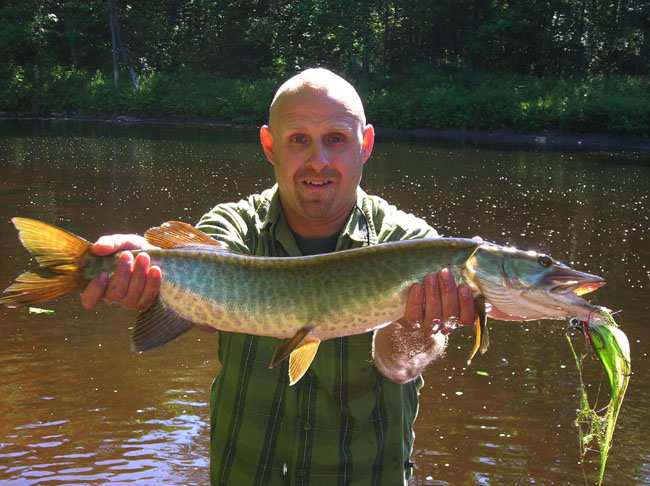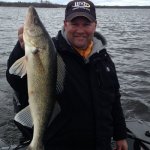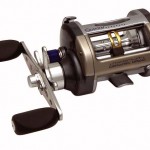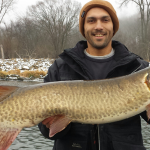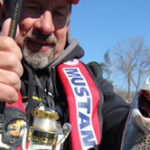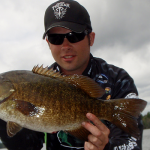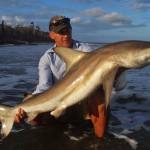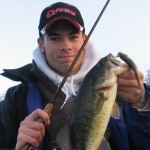By: Drew Price – Date Posted: March 13, 2012
Dialing in muskies is never an easy task with any gear but there are definitely a more than few advantages to using a fly rod. In recent years it has become much more popular. Part 1 of this article dug into gear choices, casting, leaders and other nuts and bolts. Now it’s time to put the boat in the water!
Speaking of which, boats are a necessity to fish muskies. It is not common to find musky water that can easily be fished via wading. Even if you do find water like that you can fish with your feet on the ground you won’t be able to cover the water as efficiently as you will in a watercraft. There are a lot of options for fly anglers out there. Many of us prefer people powered boats but I do have to admit that it is really nice to motor back to the launch at the end of a long day on the water. Personal preference comes into play for sure. One thing that motorless boats do provide is a great deal of stealth. Canoes, kayaks and driftboats are very quiet and can let you get quite close to fish. The vast majority of the musky fishing I have done has been out of canoes and I have been able to sight fish muskies on more than a few occasions because of how close we were able to get to the fish.
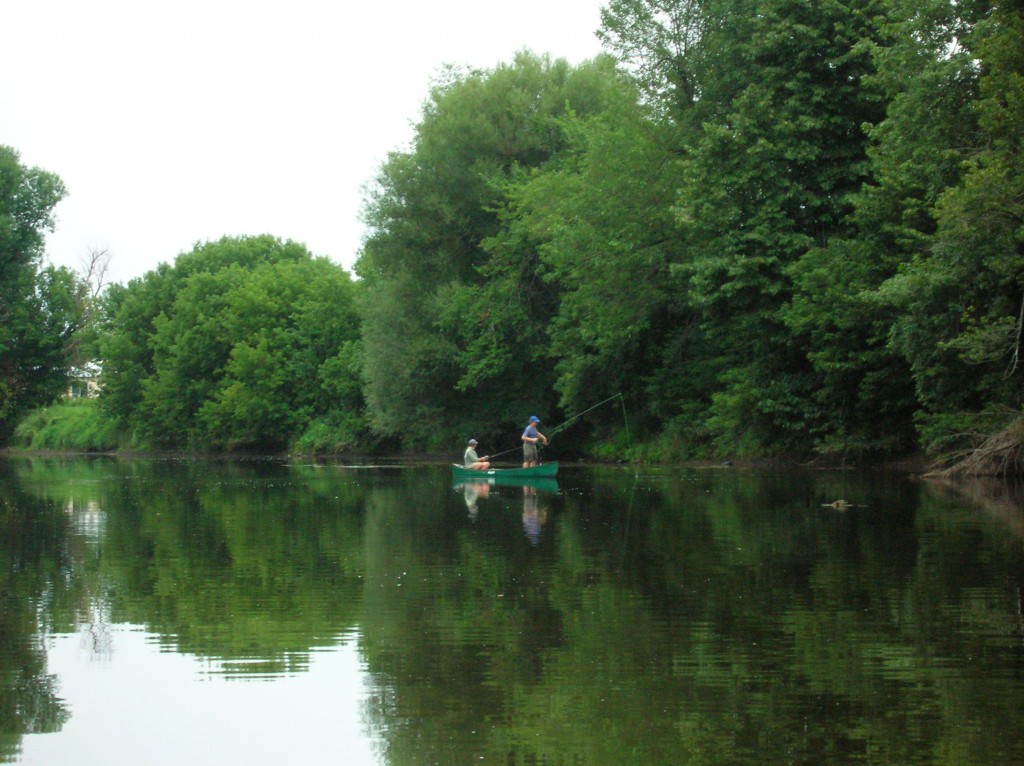
No matter what kind of watercraft you choose there are some basic rules you will want to follow when using a fly in a boat. First and foremost is to keep it clean and organized. There are times that this is easier said than done but it makes a huge difference. You are going to be casting a whole lot of line out and the more things that it can get caught up on the more trouble you will have making those casts efficiently. A good boat bag will help you keep your gear in one place and organized. I have lost tools and flies because as I let a double haul fly the line caught something that was on the deck and it flipped overboard. Check all the places and things that are part of the boat to make sure they won’t cause trouble too. Sometimes a seam of silicone in a spot where a line can get caught will save it from getting caught up (and might keep it from getting damaged- which really sucks when you have spent $80 on a fly line…). One trick that I learned from a Lefty Kreh article that can help in a boat that has a lot of gear or a lot of things that the line could get caught on is to use something to cover it up. He suggested a small tarp but what I found was a mesh decoy bag that I cut the seams on. If you sew in some weights along the edges it will stay in place and keep the line from catching.
Make sure that your boat is a good stable platform to stand in. Casting a 10 weight rod from a sitting position is a sure way to have some severe shoulder pain at the end of the day. And I can promise you that you won’t be making a lot of really long casts as well. My choice has been a wide beam flat bottom canoe with pontoons. I have done very well with this set up. Drift boats are a great choice too. Guide Brad Bohen has been using them for many years and his success rate is fantastic. There are some great, stable kayaks on the market these days too. Jackson Kayaks new Coosa is a great example of a very stable ‘yak with a lot of storage capacity.
No matter what boat you use, get comfortable with it. Know how it paddles or rides and make sure you know its benefits and limitations. Getting into a big musky in a boat you don’t know well can make landing the fish a bit more tricky. That goes with anyone you fish with. Any time in the boat will be well spent once you get into the fish of a lifetime.
Once you are out on the water in a boat you are comfortable with and are making those 80 foot double hauls, how do you retrieve that fly back to the boat? Muskies love to chase things and they can really move so it pays to be able to burn that fly back to the boat. Don’t think that you might be moving the fly too fast for the fish- you can’t move it that fast! There really are two different methods of stripping the fly in fast. The method I am most familiar with is just a single hand strip. Reach up to the stripping guide and strip 3+ feet of line in at a time and keep doing it as fast as you can. You will be tossing the line out behind you very quickly. It takes a while to get used to this kind of stripping and it can tire you out until you get used to it. It has proven itself to be very effective.
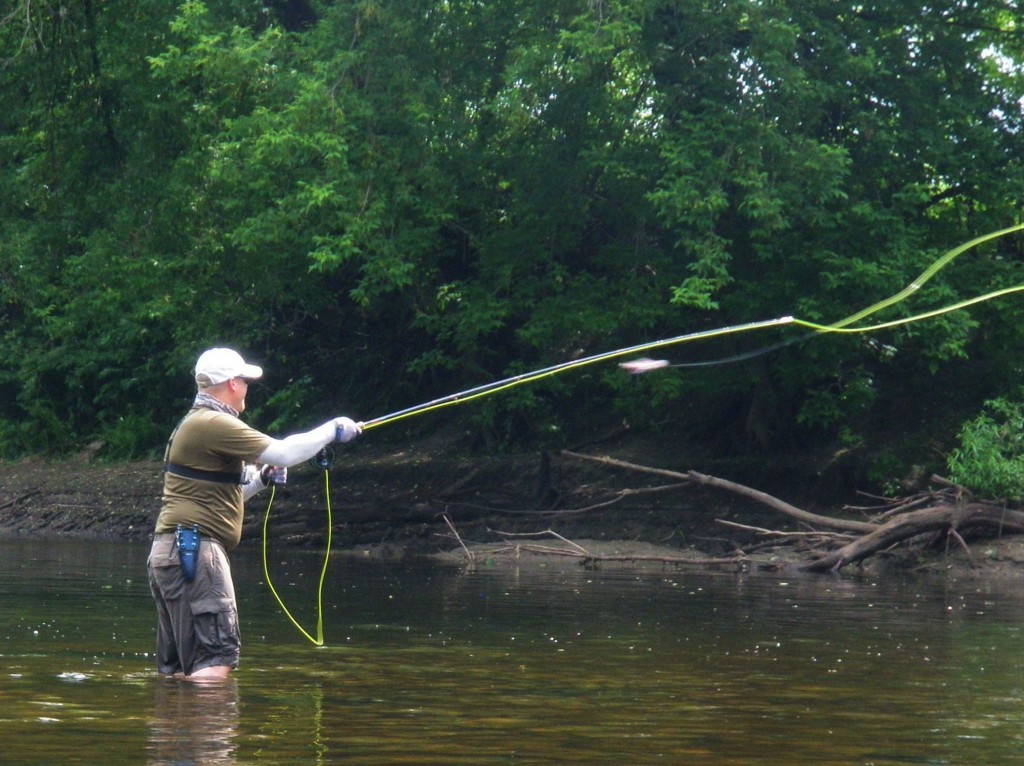
The other method of retrieval is to use two hands. After the cast you put the rod into your arm pit and do a hand over hand retrieve of the line. This is Brad Bohen’s preferred method. It is very fast if you have it dialed in. Brad puts it this way “Certainly there are times the musky need a ‘burn’ speed to get them to commit. You can strip a fly faster than anyone can reel a bait if you practice…”
Will you always need to move the fly really fast to get that take? No. But it needs to be in your bag of tricks if you are chasing water wolves. The speed of your retrieve is going to depend on a number of factors like water temperature, the fly you are using and the aggressiveness of the fish that day. Warm water temps generally mean that you are going to want to keep that fly moving pretty quickly. Cold temps will mean you slow it down. Some flies have better action if they move slow while others are really meant to be on the move. This will take some time to figure out. One thing for sure is this- if you get a fish to follow, DO NOT slow the fly down. That is one sure way to make sure that a fish does not commit. Consider what a natural prey item will do if the biggest, baddest fish in the neighborhood starts chasing it. Will it slow down? Quite the opposite, it will try to get away as fast as it can. At the very least maintain the same retrieve or speed it up. A great trick with a follow is to change the direction of the fly quickly if you can. That will often induce a strike.
The very end of the retrieve can often be the most exciting. Bohen puts it best “I live for the last ten feet of every cast!!”. Muskies will follow right up to the boat. This is the make or break moment in a musky trip. Will it take or not? Sometimes you will end up looking a huge girl right in the eyes just before she sinks into the depths. But there are things you can do to persuade a fish to take in those last moments. First thing is to bring that fly right back to the rod tip. “I see no point in casting only to pick up ten feet out to recast…you have to come all the way back as deep as you can…each and every time!” Bohen states. The classic figure 8 is one of the many things you can try when the fish is right there. That can tempt a strike from a hot fish. Sometimes pulling it right out of the water will do it to. I like to make a huge sweep with the rod as fast as I can in a different angle from the direction I was retrieving it. Will these work every time? No, but the percentages are a whole lot better than doing nothing.
Sometimes a ‘lunge will drift down to the bottom near the boat right after a the fly exits the water. My trick in this situation is to put the fly back near the fish and let it sink to the bottom. I then “hop” it along the bottom in front of the fish. When the fish shows interest in the fly I sweep with the rod to make it move really quickly. That is when the fish hammer the fly.
When the fly is in the water you need to be completely focused on it and what is happening around it. Not just now and then, EVERY time the fly is in the water. The focus on what is going on in the water and what you are doing is vital to your success as a musky fly angler. That mental state is far more important than the equipment that an angler is using. Bohen has a lot of clients in his boat over the course of a year and had this to say “I’ll take a 100% focused angler casting the ‘wrong’ set up over a 75% focused angler all dialed in! Think that one over…” Muskies can be very frustrating fish at times and being in that zone definitely improves your odds dramatically. You have to be ready to react to what the fish is going to do when the fly is in the water. If you aren’t paying attention to that you are through.
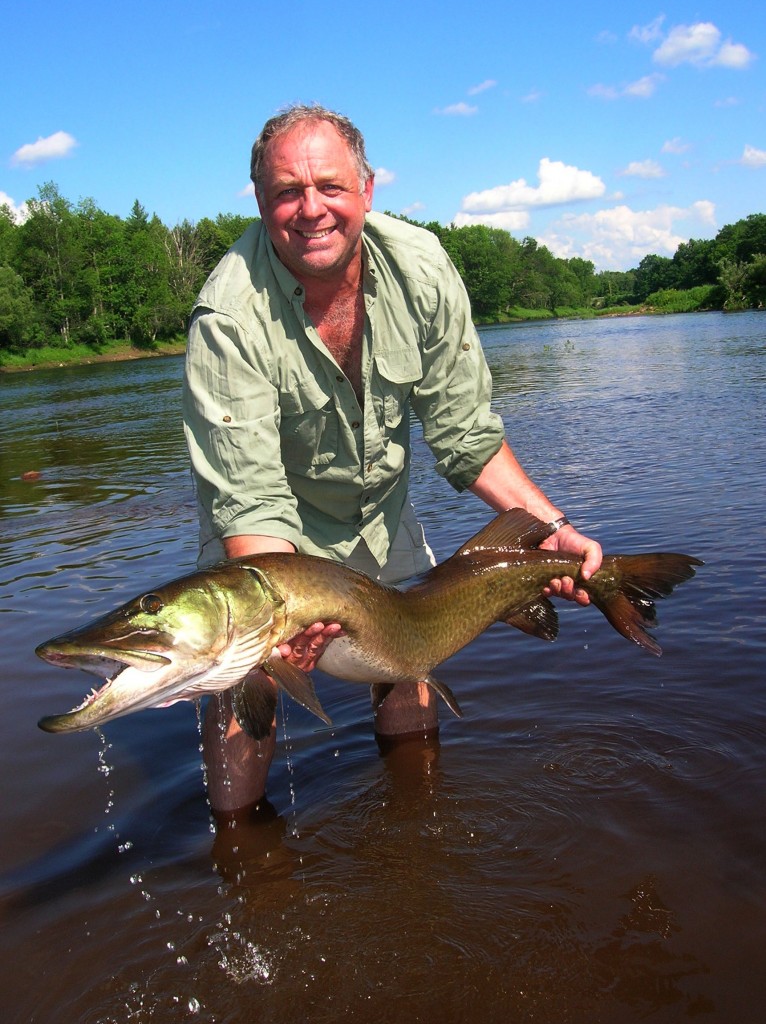
Getting the fish to take the fly is just the first part of the equation. Now you have to set the hook so it stays put. Muskellunge have a very bony mouth and a good hook set can be pretty tough to accomplish if you haven’t set yourself up to do it right. A couple of things will help with this from the start. Always keep your line tight and be in control of it. If you have slack in your line while you retrieve you are giving an advantage to the fish. If a fish takes when there is slack it can give them a fraction of a second before you set the hook. It may not seem like much but it can make a huge difference in something that happens in the flash of an eye. One of the best ways to eliminate slack is to keep your rod tip in the water. Depending on the angle that the rod is at, if your tip is off the water a foot you could have 3 or 4 feet of slack. That will not help you get a good hook set. If your line is tight and a fish grabs the fly, even if you don’t react the fish might hook itself. That is much less likely if you have any slack. A good take from a musky is not something you want to screw up- get rid of the slack!
There are two basic strikes that you should be familiar with- the standard hook set and the strip strike. A standard hook set is just quickly lifting the rod off the water to drive the hook home. Some people lift straight back while others like to set to one side or the other. With a standard hook set it is imperative to have the fly line under your fingers before setting. If you don’t then you won’t get a proper hook set because there will not be enough tension on the line. A strip strike is different. Here you are setting the hook like you were stripping the line in. It is a very sharp tug on the line which accomplishes pretty much the same thing as a standard hook set. One of the big advantages to the strip set is that if the fish misses the fly and you set, the fly will still be in the strike zone, not pulled away like a standard hook set will. If you are using the two handed retrieve then the strip set is a critical part of the game. Bohen puts it this way “two handed retrieve really sets you up for great strip-setting when you get a take”
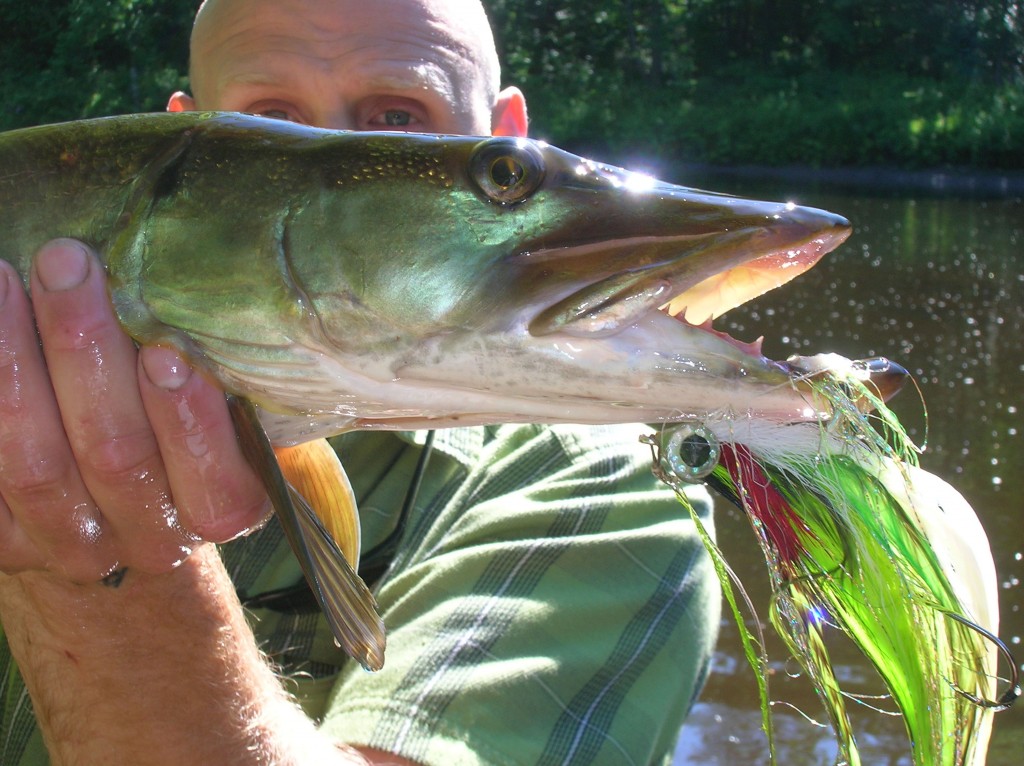
When you feel the weight of the fish on the line you need to set the hook hard. You really want the hook to get a good hold in that fish’s mouth. Waiting to feel that weight can be a tough thing at times but it does make a huge difference, especially with top water flies. I learned that lesson early in my musky fishing career. I was working a Dahlberg Diver between the bank and a branch that was in the water at a 45 degree angle. A nice musky in the mid 40 inch range (a very nice fish for this river) crashed out of the water. I immediately set the hook which pulled the fly away from where the fish landed. The musky jumped up to attack from above. I had set the hook well before the fish had come near the fly. It was a very valuable and painful lesson to learn.
Another critical piece in the musky puzzle is what is at the end of the line, leader and bite tippet- the fly itself. Good musky flies start with high quality sharp hooks. A good chemically sharpened hook will penetrate a musky’s mouth quickly and efficiently. They also tend to stay sharper longer. But a sharp hook does not always stay sharp. Routinely check your hook point after casting. If the hook does not quickly penetrate your thumbnail then it may need sharpening. Learn how to properly sharpen a hook with a file to help maintain the point that will penetrate deep and fast.
Big flies are what you need to toss at muskies. There may be times that they will take something 4-6 inches long, but for the most part a big musky wants a big meal. Remember these are fish that are capable of eating something 2/3 their own body length. Muskrats, ducks, turtles and even (allegedly) a toy poodle have been on the menu so flies 10 to 14 inches long are not out of the question. This is why the 10 weight rod is needed. Huge flies will get the job done. There are two basic categories of flies to use- streamers and topwater.
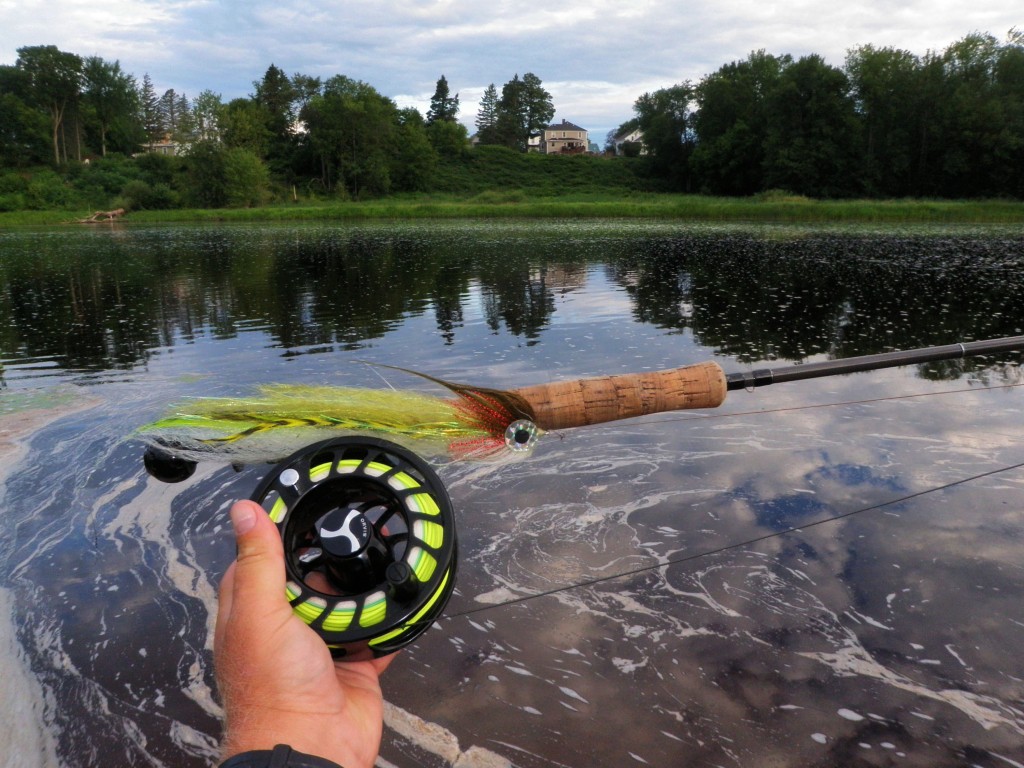
Streamer flies are a staple of musky fishing. They represent baitfish which make up the bulk of a musky’s diet. There are a wide variety of streamers available using natural and synthetic materials (or a combination of both). A well crafted streamer fly has a big profile in the water but will collapse during the cast to allow it to toss better. I have had great success over the years with variations of the Clouser Half and Half and Lefty’s Deceiver. Both of these flies have a great profile to them which likely accounts for their long time popularity. I have a real preference for weighted flies as well. I like the jigging motion that they provide and more importantly so do the fish. Other patterns make good use of flared deer hair heads to move a lot of water and articulation to provide even greater movement. Plentiful flash also helps attract attention from ‘lunge.
Topwater flies may be one of the most thrilling ways to chase muskies. When a musky takes a fly from the surface it is rarely subtle. This is where their predatory instinct really takes over and they can be downright scary. I have watched a couple of squirrels swim across musky rivers and I marveled at their testicular fortitude. Big saltwater and purpose designed musky poppers create a lot of commotion to focus the interest of ol’ Esox. Big pops can get a big crash. Divers and sliders are also very popular and with good reason. Divers are really multipurpose flies. Like their name suggests, they start off on the surface and dive down underneath when stripped but then float back to the top. Theses flies are favorites among many musky fly anglers. Divers can really shine when they are used with a sinking line and allowed to submerge. While it might seem that topwater flies are mostly for use during warmer weather, they will work in very well in water that is over 50 degrees. Muskies do seem to have a real interest in things going on on top of the water column.
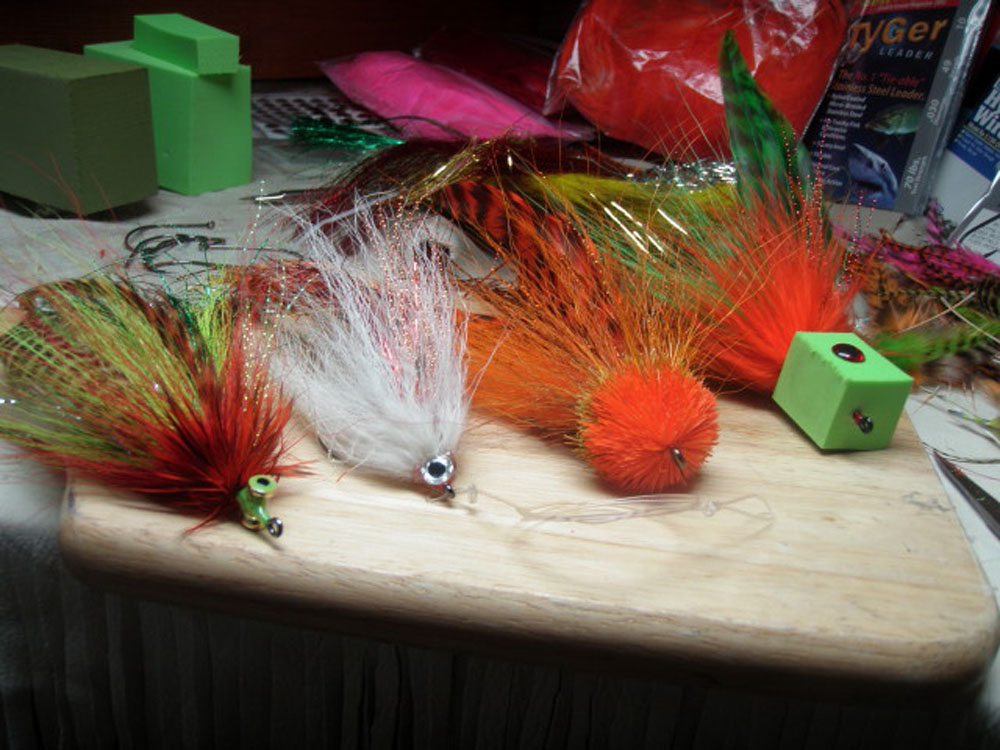
Good musky flies are not cheap. They use a lot of material and take a long time to tie. Don’t be surprised to spend $20 or more per fly for some of the better flies out there. Brad Bohen should be launching his Primo Tail Predator Flies line soon. Check out what he has to say about his flies and materials in this blog post. Another good source producing some excellent flies is Vermont Fly Guys. I have known Ken Capsey for years and can attest to the quality of his flies. They definitely get a lot of attention from pike and musky.
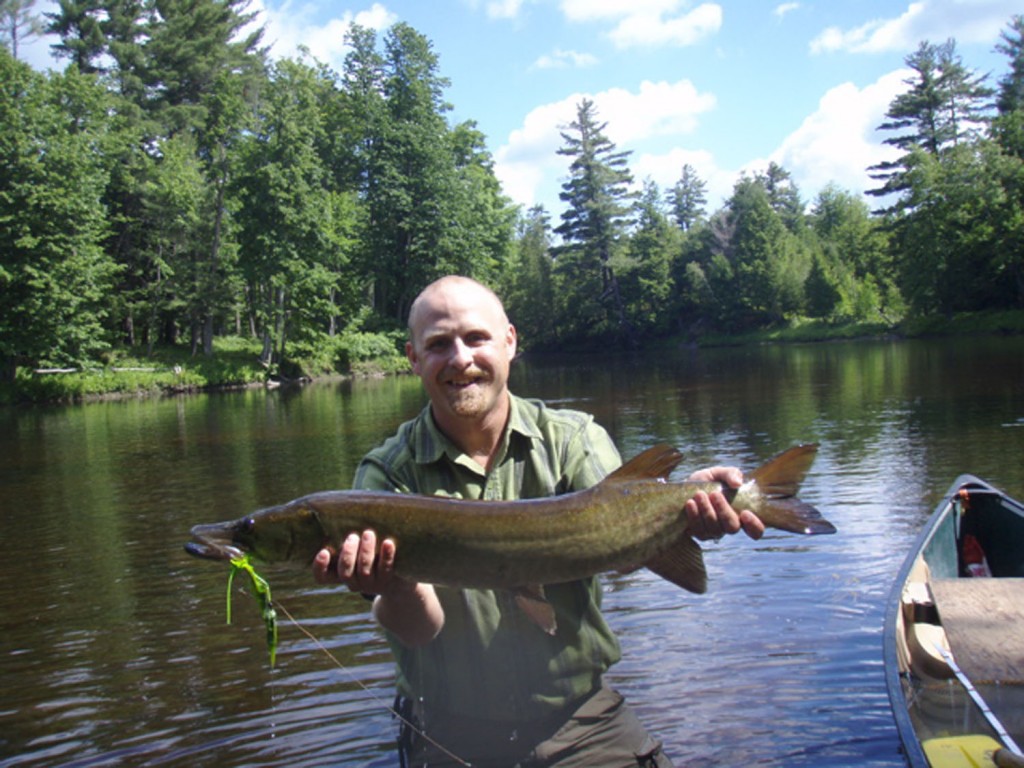
Drew grew up in Northern New York where he received his first fly rod as a college graduation present. He cut his teeth on trout, salmon and bass out of Lake Champlain tributaries but soon realized that there was a lot more to catch with flies. A true fish geek, Drew has worked at a public aquarium and routinely spews fish Latin names despite being deathly allergic to eating his finny friends. He is a science teacher for the school year and spends his summers guiding for warm water fish in the Green Mountain State. Visit Drew’s website at www.drewpriceonthefly.com/


